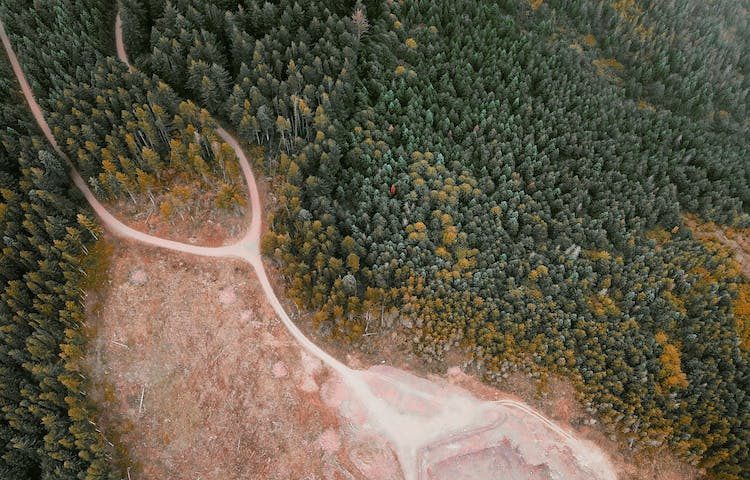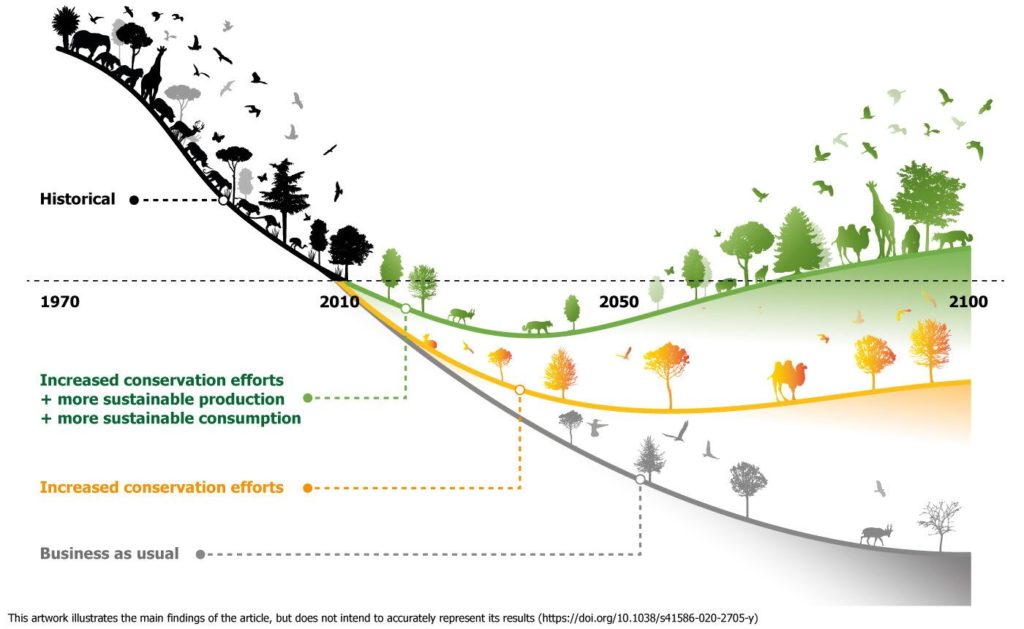A helping hand - how circular economy principles can support biodiversity
In this article, we explore how the two concepts of circular economy and biodiversity interact by looking at the impact that the current biodiversity loss has on our economies and societies, and how circular economy principles can help to tackle this crisis.

In the midst of an uncertain threat
The climate emergency is one of the biggest threats to humans on this planet. One aspect which is closely intertwined with a hotter climate and rising temperatures is the loss of biodiversity on our planet. Oftentimes, this important aspect gets too little attention, even though the impact of declining biodiversity on our planet is tremendous.
There are several organisations that are monitoring and investigating the current state of biodiversity worldwide. For example, the Living Planet Index by WWF is analysing the state of roughly 32,000 populations of over 5,200 species worldwide and they have found that there has been a 69% decline in biodiversity from 1970 to 2018 (WWF, 2022a). The International Union for the Conservation of Nature (IUCN) is coming to similar alarming results: Their Red List of Threatened Species monitors around 140,000 species by population. Scientists working for IUCN have found that 47,000 of them are threatened with extinction (Guardian, 2022).
This loss in biodiversity has a tremendous effect on our lives as humans. Studies have shown that less biodiversity leads to less stable ecosystems, which are crucial for our economies to thrive. This is because we are depending on ecosystem services. For example, our economies depend on extracting resources from ecosystems, such as wood from forests. But there are other, more hidden ecosystem services, such as the provision of clean water we can drink, healthy soils we can grow food on, and even clean air to breathe. Ecosystems also provide recreational and cultural services to humans, which we often experience when wandering through a forest nearby, or when visiting a national park (earth.org, 2023).

How linear economy principles are fuelling biodiversity loss
Our current economic paradigm, mostly following linear economic logic, plays a crucial role in intensifying biodiversity loss. For example, global warming, caused majorly by human linear economic activities of fossil fuel combustion, is an issue that is affecting ecosystems on a global scale, as it leads to rising temperatures, intensified droughts, flooding, and ocean acidification (IPCC, 2023). One example of an ecosystem affected by this are coral reefs (UNEP, 2021). Apart from holding an immense recreational value, coral reefs also protect coastline from storms and erosion, and offer a source of food and new medicines (NOAA, 2019).
Other more local activities that have a negative impact on ecosystems are linked to linear material extraction following the take-make-waste principle. For example, logging and agricultural expansion are big drivers of deforestation, resulting in roughly 20 percent of reptile species being put at risk (UN, 2023). Deforestation also leads to desertification and land degradation, which has a dramatic impact on global economies. The United Nations have analysed that this trend can cost up to 10 percent of the global gross domestic product in loss of biodiversity and ecosystem services (UNEP, 2019). The linear economy also affects biodiversity on the downstream side of the value chain: Waste has become a major issue in many countries worldwide, locally affecting different ecosystems on land and below water.
For example, the inadequate management of manure from industrialised livestock farming leads to the generation of environments toxic to fragile ecosystems. Nutrient pollution from the United States into the Gulf of Mexico, for example, led to the generation of a so-called ‘dead-zone’ of roughly the size of the state of Delaware (FAIRR, 2023; The Nature Conservancy, 2023). Other pollutants, such as chemicals and plastics, also cause serious threats to underwater ecosystems. A 2022 WWF study found that microplastics and macroplastics alike are harming small and big animals, disrupting food chains which ultimately affects ocean-dependent economic sectors such as tourism and fisheries (WWF, 2022b).

How can the circular economy provide a solution to declining biodiversity?
These developments are shocking. But there is hope, as it is becoming ever more clear that the circular economy can act as a solution to combat the biodiversity crisis. Just like the diversity found in the genetic pool of biotic life, we need to diversify our way of using natural resources. The Ellen MacArthur Foundation shows the role that the circular economy has to play in this, describing three crucial principles we need to follow in order to restore and safeguard biodiversity and ecosystem services (Ellen MacArthur Foundation, 2021).
Firstly, we need to eliminate waste and pollution, to reduce threats to biodiversity. For example, designing out unnecessary single-use plastics will reduce wastes, and stopping nutrient pollution into the Gulf of Mexico by enhancing waste management will reduce stressors in local ecosystems.
Next, the circulation of products and materials will leave room for biodiversity. Reduced logging will halt deforestation and land degradation, allowing species to live in their natural habitat and maintain their population size, as outside stressors are reduced. The transition to renewable energy is of utmost importance to reduce global warming worldwide, to stop and turn around global climate effects like extreme floods and droughts. Reuse and Recycling, Refurbishing and Repair leads to less products and materials reaching their end of life, and thus, less pollution.
Thirdly, we need to regenerate nature, to truly enable biodiversity to thrive, and become ever more resilient. So economic activity needs to become ‘nature positive’ – not produce less harm, but rather actively have a positive effect on ecosystems. For example, regenerative agricultural techniques such as agroecology and agroforestry improve soil health and sequester carbon in it.
What is more? When it comes to rethinking business models, products and services, circular economy principles offer room for innovation to a greater extent than linear economy principles. This can have a serious positive impact on biodiversity: For example, business models based on the repair and refurbishment of, for example, electronic devices, save resources such as rare earths, and thus, lower destruction of ecosystems where rare earths can be found, such as the deep sea.
Lastly, the circular economy can enhance biodiversity through collaboration and partnerships. By truly connecting supply chains not only upstream to downstream, but across industries and sectors, awareness for biodiversity issues and its consequences is created, which will make a stronger case for its preservation.
Keeping these principles in mind, the circular economy can act as a lever for halting biodiversity loss and improving ecosystem services worldwide. Circularity gives a real chance to design and alter today’s economy in a way that it can thrive and develop in balance with the natural environment, to safe-guard the rich genetic pool of life we depend on so much.
Sources
earth.org. Derived from: https://earth.org/effects-of-biodiversity-loss/
Ellen MacArthur Foundation, 2021. The Nature Imperative: How the Circular economy tackles biodiversity loss. Derived from: https://ellenmacarthurfoundation.org/biodiversity-report
FAIRR, 2023. Derived from: https://www.fairr.org/engagements/biodiversity-engagement/
Guardian, 2022. Derived from: https://www.theguardian.com/environment/2022/dec/06/the-biodiversity-crisis-in-numbers-a-visual-guide-aoe
IPCC, 2023. Synthesis Report of the IPCC Sixth Assessment Report – Summary for Policymakers. Derived from: https://www.ipcc.ch/report/ar6/syr/
The Nature Conservance. Derived from: https://www.nature.org/en-us/about-us/where-we-work/priority-landscapes/gulf-of-mexico/stories-in-the-gulf-of-mexico/gulf-of-mexico-dead-zone/
NOAA, 2019. Derived from: https://www.noaa.gov/education/resource-collections/marine-life/coral-reef-ecosystems
United Nations, 2023. Life on Land. Derived from: https://www.un.org/sustainabledevelopment/biodiversity/
UNEP, 2019. Derived from: https://www.unep.org/news-and-stories/story/warning-sixth-mass-species-extinction-cards
UNEP, 2021. Derived from: https://www.unep.org/news-and-stories/story/why-are-coral-reefs-dying
WWF, 2022a. Derived from: https://www.wwf.de/living-planet-report
WWF, 2022b. IMPACTS OF PLASTIC POLLUTION IN THE OCEANS ON MARINE SPECIES, BIODIVERSITY AND ECOSYSTEMS. Derived from: https://www.wwf.de/fileadmin/fm-wwf/Publikationen-PDF/Plastik/WWF-Impacts_of_plastic_pollution_in_the_ocean_on_marine_species__biodiversity_and_ecosystems.pdf
